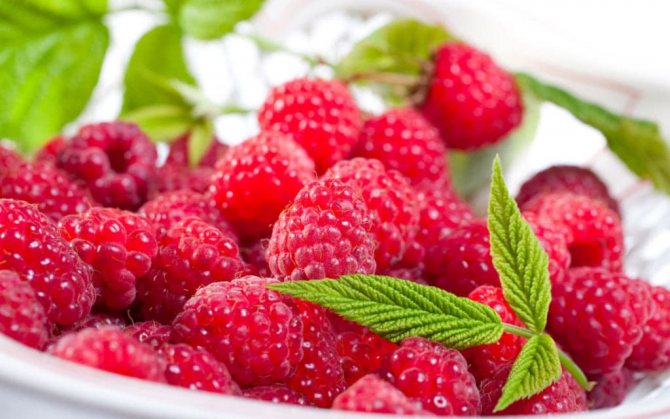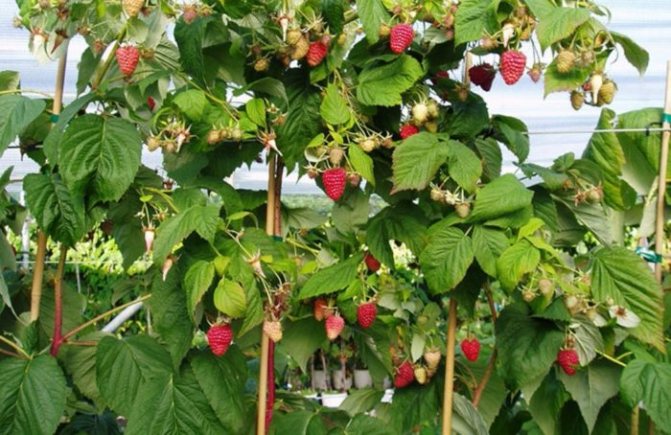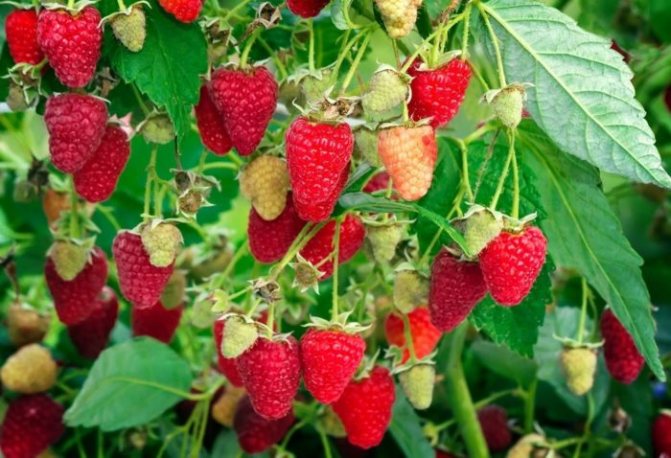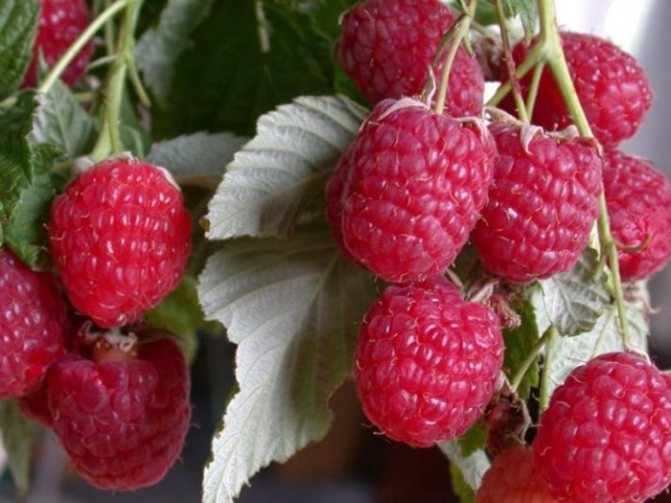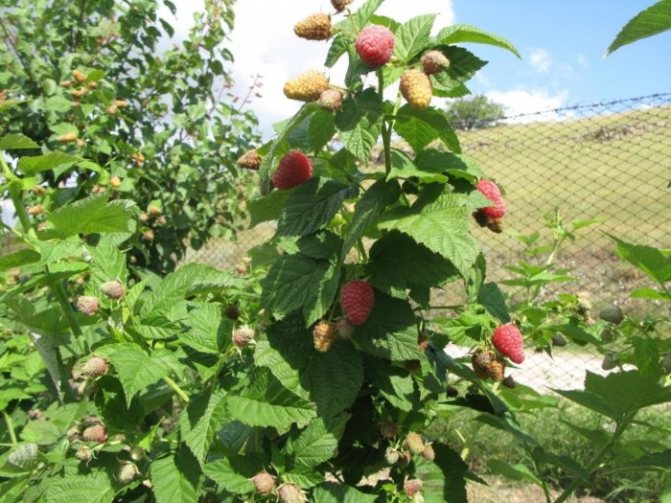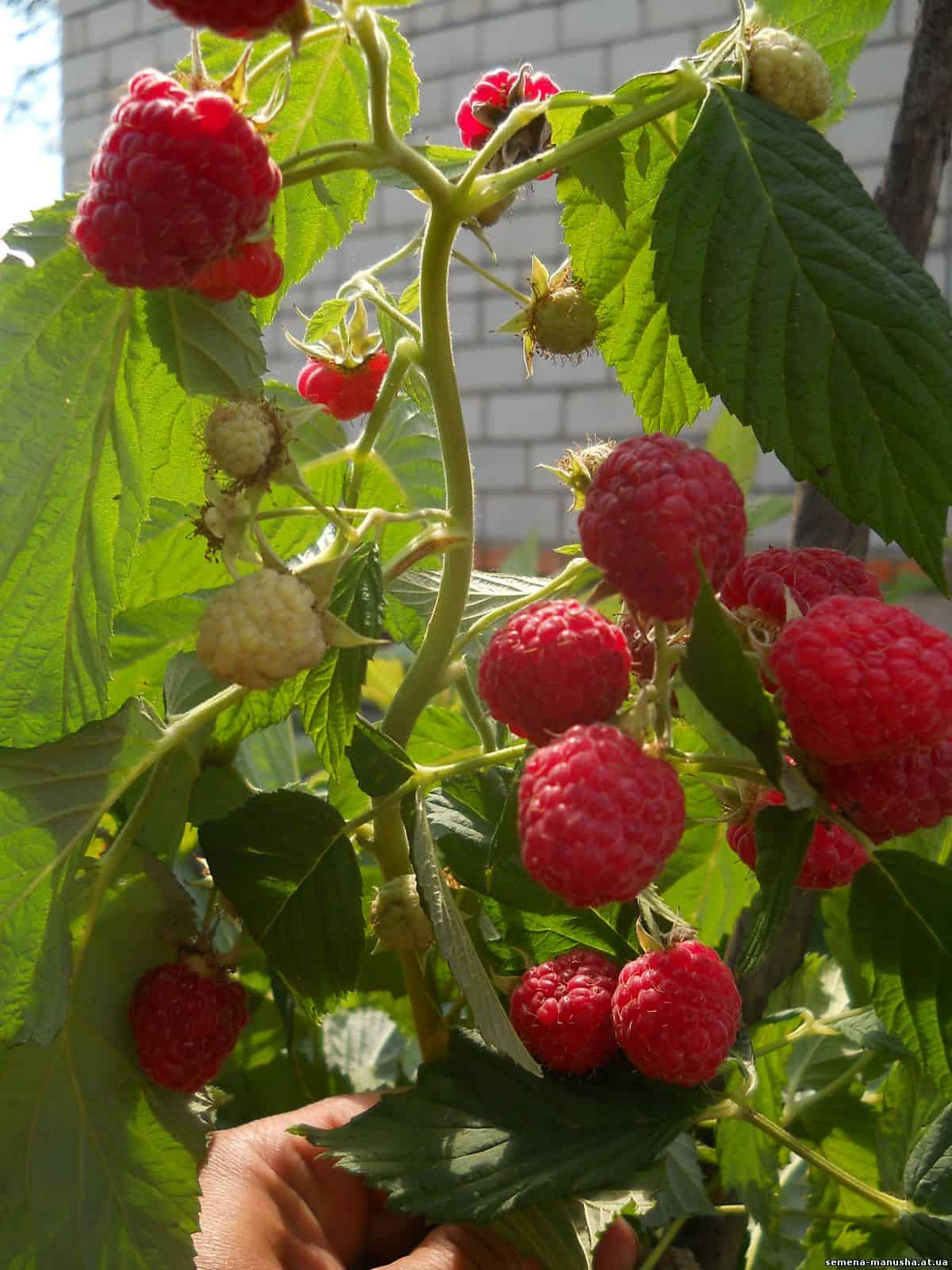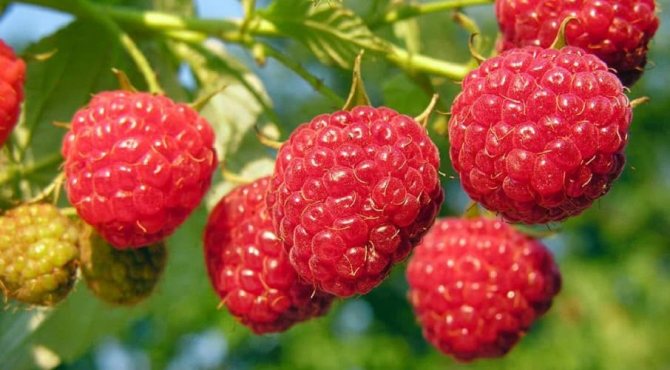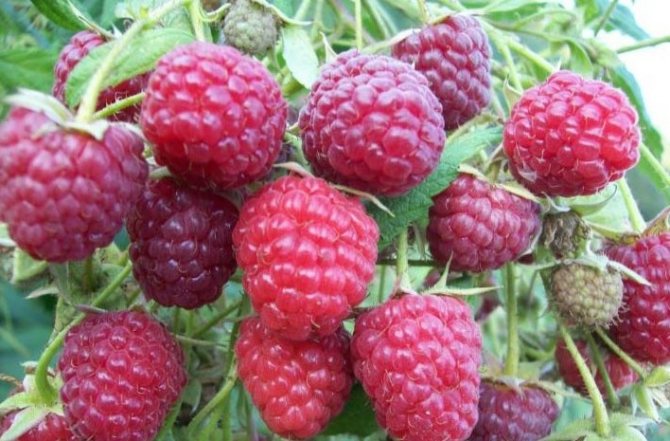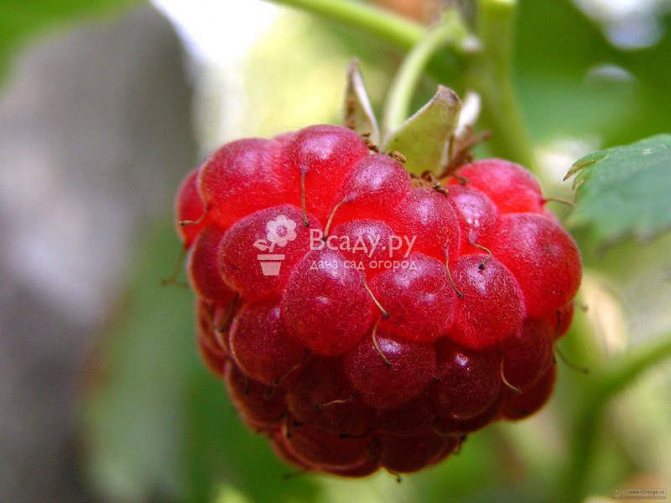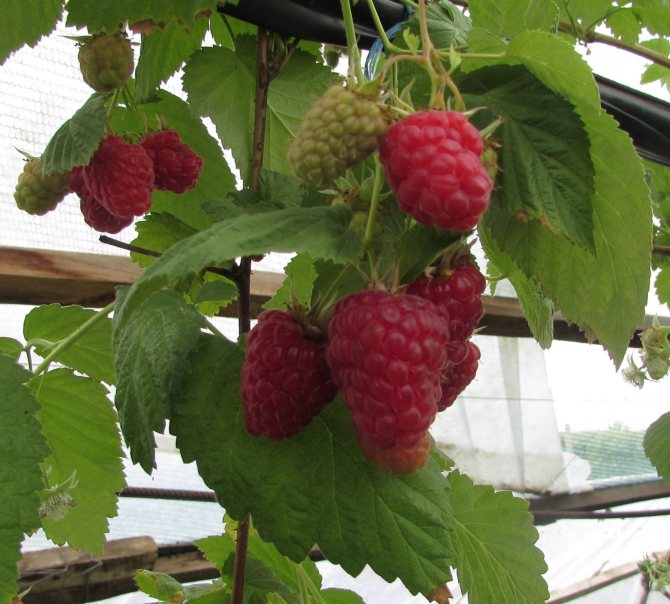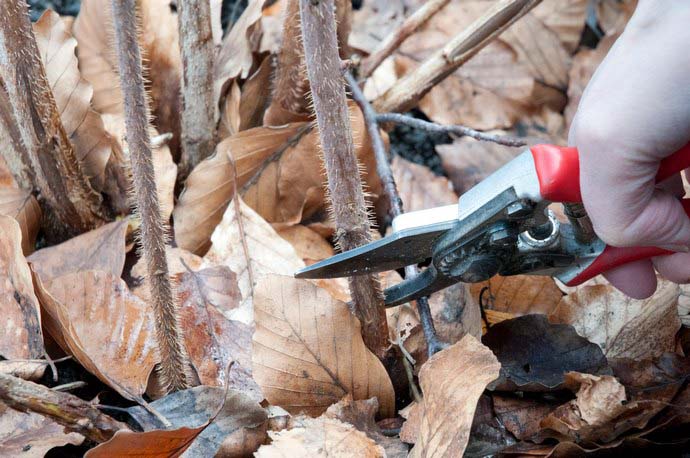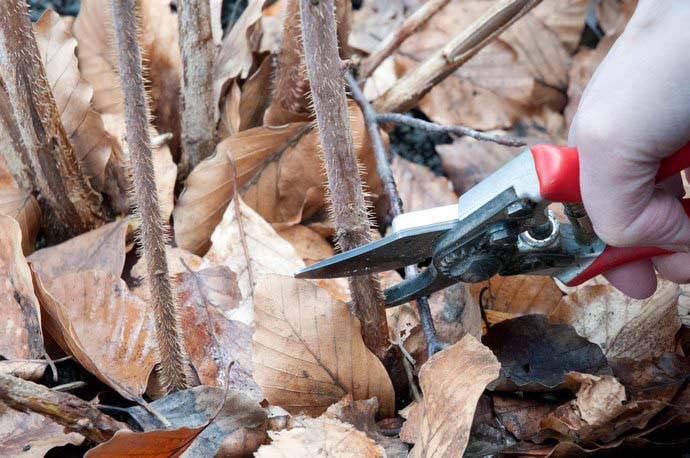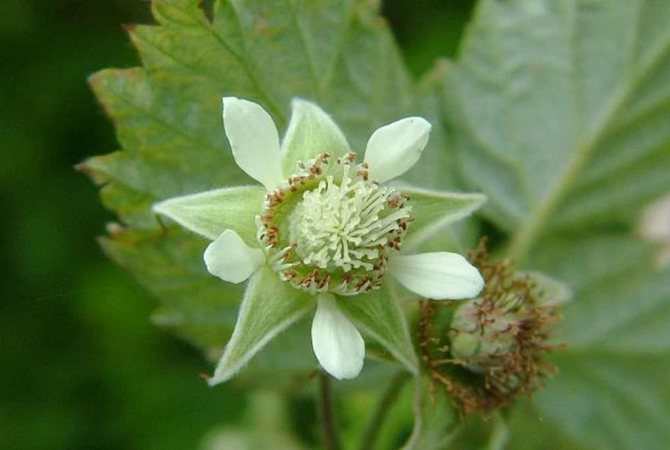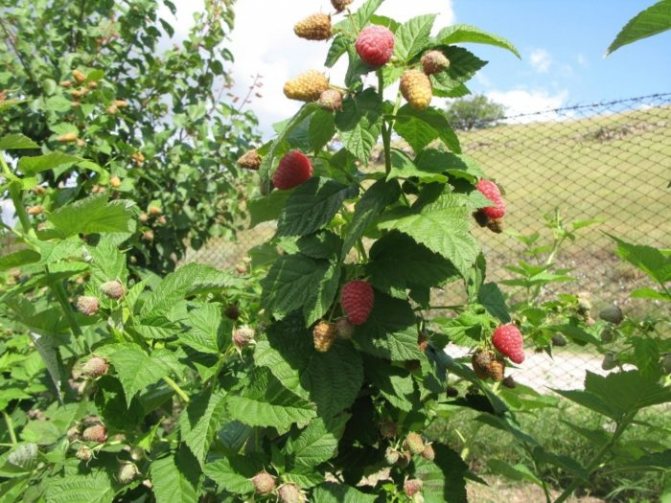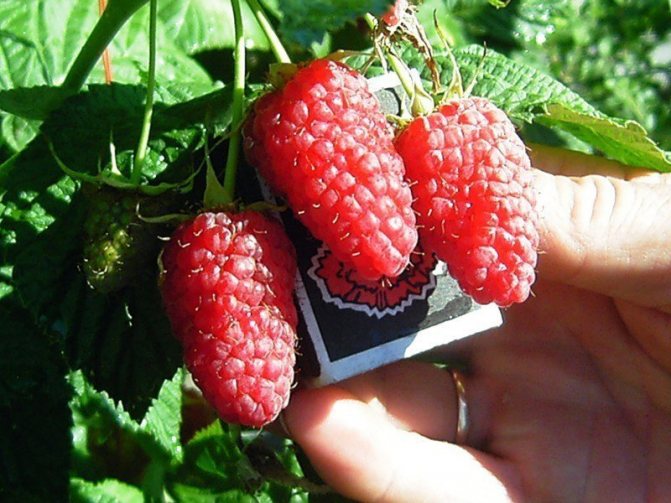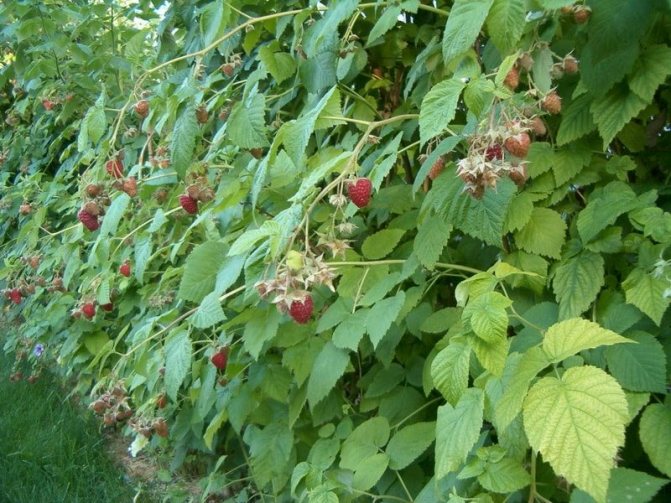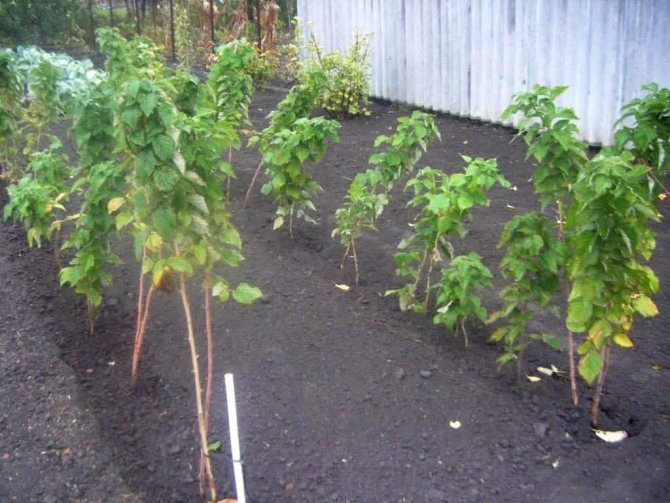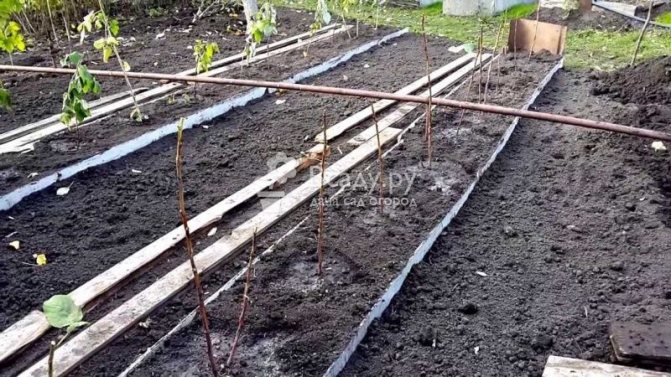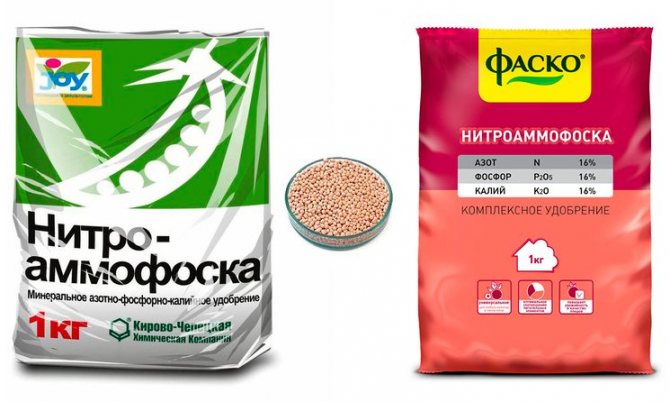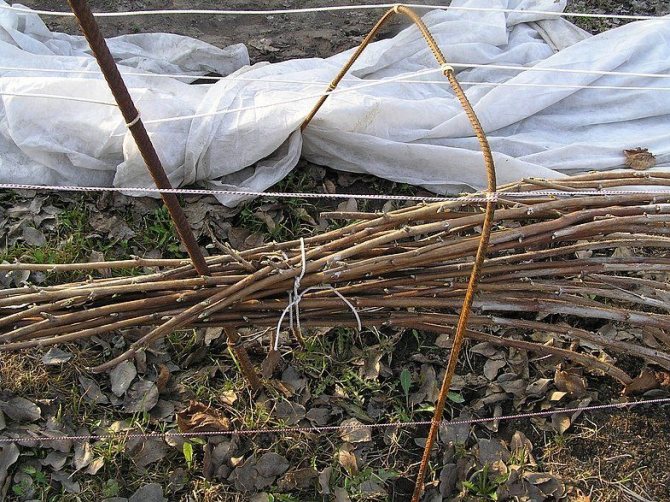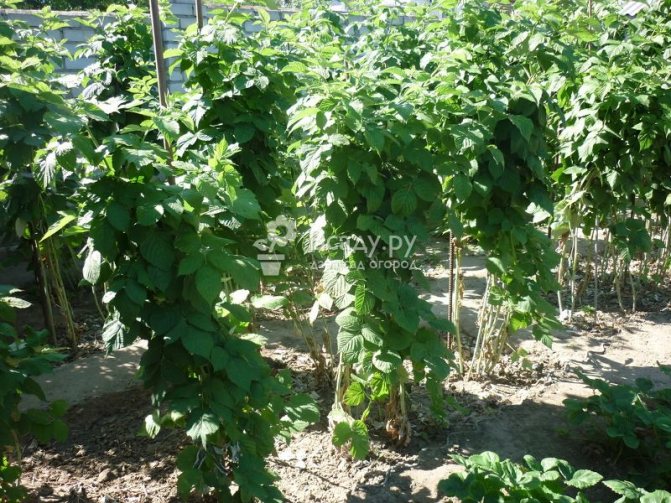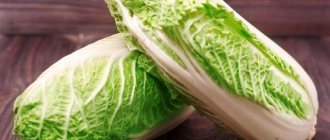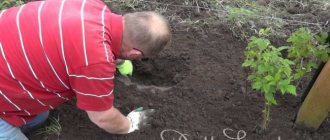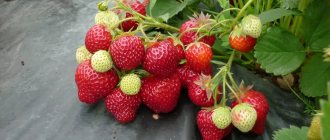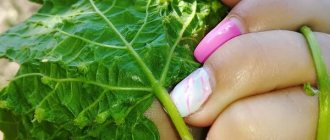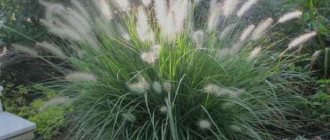Recently, more and more often you can hear about the raspberry tree. What kind of miracle is this and how does it differ from everyone's favorite bush raspberry? In fact, there are no miracles. The raspberry tree, or standard raspberry, is a plant with a thick trunk reaching a height of 2 meters. Planting standard raspberries is a modern direction of breeding science, which has recently become widespread. There are several varieties of such raspberries and one of the most popular is "Krepysh". It seems that this variety consists of some advantages. But is it really so? Let's figure it out together!
Sturdy Description
The common raspberry is called the raspberry tree. Indeed, a developed adult plant vaguely resembles a small tree, but this is the same bush as all other types of raspberries.
Bushes
The variety lives up to its name - the plant is strong and stocky. Not only the main trunk, but also the rest of the shoots are thick and hard. The shrub of the standard type, 1.8 m high, can reach 2 m. Powerful thornless shoots (up to 2 cm thick) have short internodes and multiple lateral branches.
In the first year after planting, the color of the stems is green, in the second year their color becomes yellow-brown. The leaves are strongly corrugated, dark green. Fruit branches are formed only in the upper part of the plant. There are a lot of them, they are short, compact.
Berries
Fruits of a rich red-raspberry color, without shine, of a beautiful blunt-conical shape, large, weighing up to 10 g. A big plus is the dense pulp of the berries, thanks to which they have a dry surface, remaining juicy inside.
Raspberry fruits Krepysh are endowed with an interesting feature: just before ripening, literally in 1-2 days, there is a rapid increase in the size and weight of the berries.
Ripe berries are easily separated from the stalks, do not deform during collection and transportation. Overripe fruits do not crumble, but gradually dry up, remaining on the branches.
Description of the variety
Raspberry sturdy is a standard plant. This means that he needs support for normal growth and development. The variety was bred by the Russian breeder V. Kichina at the Kokinsky base. A distinctive feature of standard plants is that they reliably hold berries and branches often bend under the weight of the harvest. The garter to the support prevents them from breaking off and helps shape the crown.

But "tough guy" is called that because this precaution is not obligatory for him. The shrub has powerful and large stem branches with short internodes and an abundance of lateral shoots. The fruits ripen in the upper part of the bush, which makes it possible to compare a sturdy man with a small tree.
The peculiarity of the variety is that it bears fruit throughout the summer and the first half of autumn, right up to the first frost. This is its advantage and disadvantage. The "plus" is that the gardener always has a harvest of fresh berries. The "minus" is their uncooked, uneven ripening, which requires constant attention and regular collection of berries.
This can be a serious problem when growing the variety on an industrial scale or at the large farm level. But for a small summer cottage in growing raspberries, there are more positive sides than negative ones.
Variety characteristics:
- high growth rate;
- at
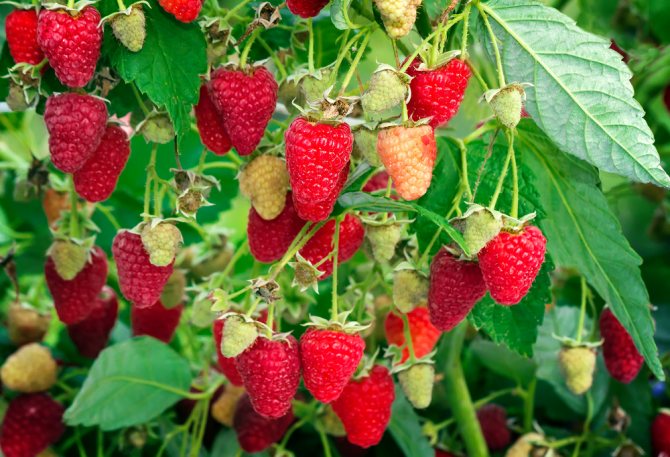

fertility with proper care - up to 4 kg per bush; - reaches a height of 180-200 cm;
- the tops of the shoots are strong, do not bend under the pressure of the wind and the weight of the fruits;
- viable, able to tolerate frosts down to -30 ° С;
- shrub without thorns, which makes it easier to care for and harvest;
- flowering period - June-July;
- fruits ripen on last year's shoots.
The berries are distinguished by high taste, sweet, with a pronounced aroma. The color is bright red. The size is large, the average weight is 6-8 g. One of the advantages of the variety is that the berries hold well on the stalks and do not crumble even in a state of full maturity. They are distinguished by high keeping quality and, in comparison with most other varieties, retain their presentation for a long time. This is important when growing raspberries for sale.
See also an article on a similar type of raspberry: Tibetan raspberry (rose-leaved)
Advantages and disadvantages of the variety
The advantages of the Krepysh variety include:
- stable generous yields with competent agricultural technology;
- large beautiful berries;
- the absence of thorns on the stems, which makes picking berries more convenient;
- high frost resistance;
- the strength of the stems;
- increased resistance to diseases and pests;
- there is no need for supports;
- prolonged fruiting;
- the bush has a weak thickening of the shoots, does not grow;
- the dense structure of the fruit allows maintaining high commercial qualities during transportation and storage.
Weaknesses of the variety:
- long wait for the first berries and full fruiting;
- uneven maturation (for commercial cultivation);
- the bush does not tolerate mechanical damage;
- sensitive to transplantation, long survival period in a new place.
See an overview of the Krepysh raspberry variety in the video below:
Standard varieties or raspberry trees
A trunk is usually called a tree trunk without leaves from the roots to the beginning of crown growth. In principle, from almost any variety of raspberries, especially remontant, you can create a standard form - the so-called raspberry tree. But at the end of the last century, scientific breeders managed to bring out special varieties of raspberries, distinguished by especially strong and thick shoots that grow exclusively straight.
Of course, this raspberry is still far from the trees, it grows as an ordinary upright bush. But the main feature of these varieties is that, upon reaching a certain height, the shoots begin to actively branch and a large number of fruit branches are formed on them, imitating the crown of a tree.
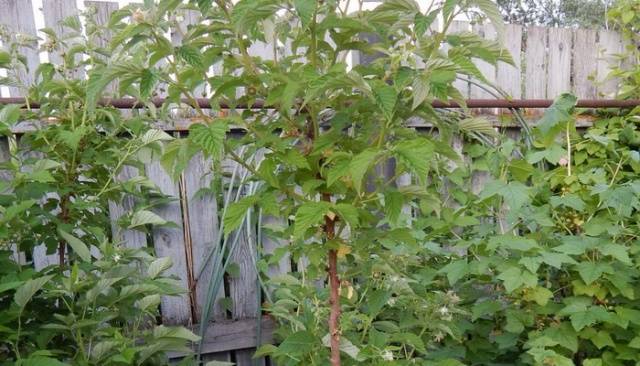

Raspberry Krepysh can also grow in the form of a raspberry tree, as can be clearly seen in the next video.
Ripening time and yield
Raspberry Krepysh is cultivated in the Central and Central Black Earth regions, in the Kuban and in central Russia.
This is a mid-early variety. The ripening time of Krepysh is June-August. Ripening dates may slightly shift in one direction or another, depending on weather conditions. The berries ripen more actively in the sun than during prolonged rains.
The harvest ripens on last year's shoots, and unevenly. This has its pros and cons. The plus is that you can feast on fresh berries for a long time, but the minus, rather, concerns commercial gardening. Such uneven ripening is a serious obstacle in the collection and sale of the crop.
In one cluster of 6-9 berries, only one can be ripe, the rest will take 1-2 weeks to ripen.
The yield of Krepysh raspberries is high. With proper agricultural technology, up to 4 kg of berries can be removed from the bush.
Yield
The first berries from the Krepysh raspberry plantings can be tasted in the second year, and you will be able to enjoy the full harvest only in the fifth year after planting the seedlings.
Subject to competent agricultural technology, from one raspberry tree of the "Krepysh" variety, you can collect from 3 to 5 kg of fragrant and tasty fruits, from which you can prepare:
- jam;
- confiture;
- marshmallow;
- jam;
- mousse;
- compote;
- the juice;
- liqueur;
- liquor;
- wine.
Raspberries, which contain a huge amount of vitamins, macro- and microelements, are best consumed fresh, but they retain most of their beneficial properties even when the fruit is frozen. The dried berries can be used both in cooking and as a healing agent used to treat many colds.
Sapling selection
You need to approach the purchase of a seedling responsibly, good yields can only be expected from high-quality planting material:
- a branched root system with an abundance of small roots is important for a seedling;
- the diameter of the stem of a young standard seedling is at least 1 cm;
- the stem is woody, strong;
- no swelling on the stem.
The presence of a woody stem and a developed root system will make it easier for the plant to adapt to a new place. The length of the stem does not matter, anyway, it is shortened when planting, its diameter is important. Saplings with a thin stem have poor survival rate.
The stem of a plant acquired in the nursery usually has already removed the buds from the roots to a certain height. This will be the raspberry stem. The seedling is already initially prepared for correct development and formation. Above the stem, buds should be located, from which fruiting shoots will later grow.
In the air, especially in the sun, raspberry roots dry out quickly, so the root system of the acquired seedling is wrapped in a wet cloth and placed in a plastic bag.
Growing
The best place for planting a raspberry tree is an area that is well lit by the sun and at the same time protected from the penetration of northerly winds. In the summer, they will not harm the plants, and in the winter, carrying frost with them, they are able to provoke the complete freezing of plantings. A wall of a building or a fence can act as protection from the wind.
In order for raspberry seedlings to remain under the sun's rays as long as possible during the day, their rows should be arranged from south to north. It has been found that plants located in well-humid and sunny areas give higher yields and tasty fruits than those planted in partial shade.
An equally important condition that can affect the choice of a site for a raspberry tree is the level of occurrence of groundwater. In order for the Krepysh raspberry to develop successfully, and its roots do not rot, it must pass at least 1.5 m from the soil level. If the groundwater is close to the surface of the earth, raspberry seedlings can be planted on mounds or raised ridges at least 40 cm high.
Landing methods and dates
Standard raspberries can be planted both in the spring (from the last decade of March to the beginning of May) and in the fall (from the last decade of September to the end of October). Autumn planting is preferable, because at this time the plants take root better than during the period of sudden temperature changes.
Planting of standard raspberries is carried out:
- Using a tape (or trellis) method, in which it is necessary to dig a trench (about 50 cm wide and about the same depth), introducing a complex of the necessary organic or mineral fertilizers into it and pulling the trellis - an auxiliary cord.
- By the bush method, which involves digging individual holes (at least 40 cm in diameter and up to half a meter deep), located 100 cm apart. With this planting method, fertilizers are applied to each pit.
Raspberry planting scheme by trench (tape) method:
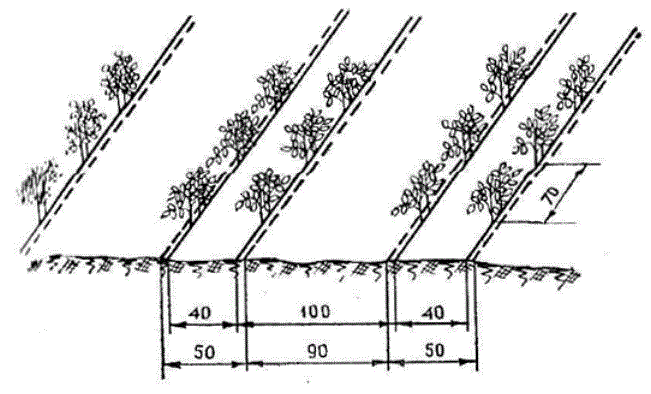

If the plants are planted in rows, the distance between them should be at least 2 meters.
The trellis planting method is more suitable for small areas, while the bush method is intended for large areas, on which you can easily place any number of powerful, lonely bushes.
Site preparation
If the planting of seedlings will be carried out in the autumn, the soil for the future raspberry tree should be prepared at least 4 weeks before this moment; for spring planting, this period can be reduced to 2-3 weeks.
To fertilize infertile clay soil, use wood ash or powdered lime, scattering them over the soil surface before digging the site (for every square meter of fertilized soil, you will need a handful of wood ash and 500 g of lime).
For the same purpose, you can use natural organic matter (compost, humus, mullein manure) or nitrogen-containing mineral fertilizers. Having spread them out over the surface of the site, they begin to embed them in the soil by digging. In this case, you can also use wood ash or lime.
Natural organic matter is introduced at the rate of: 10 kg of fertilizer per sq. meter of earth. To calculate the amount of mineral fertilizers, use a matchbox: for each square. meter of soil will require 3 box of nitroammophoska or 1 box of nitrate.
Selection of seedlings
Good quality of planting material is a guarantee of obtaining the expected result, therefore, when choosing seedlings of the "Krepysh" variety, you must opt for plants:
- Possessing a strong woody stem, the diameter of which is at least one centimeter in diameter.
- Having at least three well-developed buds at the base of the stem, from which fruit vines will subsequently develop.
- Possessing a well-developed root system, which has a large number of small roots, called "lobe".
It is not recommended to purchase seedlings with less than three buds, as this indicates a too young age of the plant, which needs a longer period of time necessary for the formation of shoots and growth.
A woody stem, as a rule, is possessed by seedlings with a sufficiently branched root system, which guarantees quick adaptation to new growing conditions.
The length of the stem does not really matter, since it will still have to be shortened at the time of planting on the site, while its diameter is a very important feature. Saplings with a thin stem take root much worse than those with strong and thick shoots.
So that the roots of the purchased seedlings do not dry out in the sun, you need to wrap them with a damp cloth and plant them in the designated place as quickly as possible.
Step-by-step planting instructions
- On a site with pre-prepared soil, planting holes are dug (at least 50 cm deep and up to 60 cm wide).
- Humus (at least buckets), wood ash and nitroammofoska (150 g) are introduced into each pit.
- Having placed the seedling in the hole and making sure that the root collar is buried no more than a couple of centimeters, the roots are carefully covered.
- Having planted a plant, they prune its shoots to 30 cm.
- Having made a near-trunk circle with a roller that helps to collect rainwater, the soil inside it is mulched with a thick layer of organic matter (straw, humus, fallen leaves, peat, hay or sawdust).
- Completing the planting, at least 5 liters of water are poured under each bush.
Choosing a seat for landing
For planting standard raspberries, they choose a sunny, flat surface, and a site protected from northern winds. The place under the raspberry tree should not be flooded by rain and melt water. The plant does not tolerate excess moisture.
For good fruiting, a strong man needs a soil of slightly acidic or neutral acidity, fertile and breathable. Groundwater should not be higher than 1.5-2 m from the surface of the earth.
When planting raspberries along the borders of the site, you need to retreat from the fence by about a meter. But the best option would be a compact planting in rows, in a square.
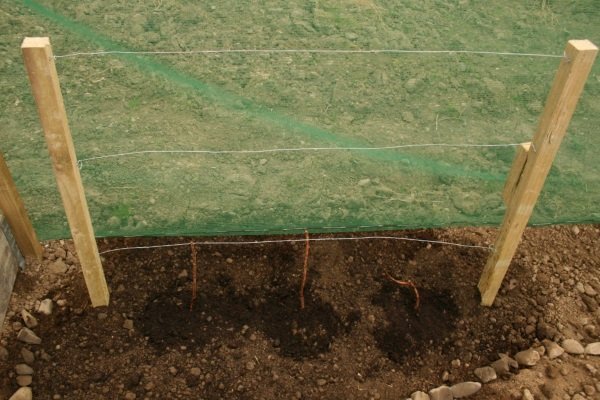

Good precursors for raspberries: cucumbers, courgettes, onions, garlic, and parsley. You should not plant raspberries where tomatoes, peppers, potatoes, strawberries, eggplants grew.
Landing features
In order for the standard raspberry to grow well, it must be planted correctly, provided with care during the growing season and formed a stem.
Site selection and preparation of planting material
For Krepysh you need to choose a flat area or with a slight slope. It must be sufficiently lit. The bush must be protected from the effects of strong winds and drafts, otherwise it will need an additional fence.
It is best to choose fertile soil for growing, with neutral acidity. The site should not be swampy - a suitable level of groundwater at a depth of 1.5 meters and below.
The land for raspberries should be prepared in advance - at least a month in advance, or better yet. To do this, the planting site is cleared of weeds, sand, ash, peat are added to the soil, then all the ingredients are thoroughly mixed.
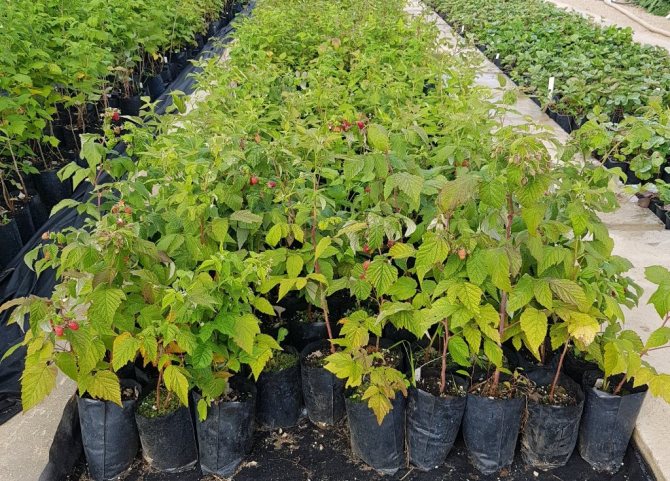

Varietal raspberry seedlings
It is best to buy seedlings for propagation from nurseries and trusted sellers.
When choosing planting material, you need to pay attention to important details:
- the base of the trunk must be at least 2 cm in diameter;
- many small processes are visible at the root;
- the minimum number of buds on the stem is 3 pcs.
Preparatory work
Raspberries prefer light, well-drained soils rich in organic matter and mineral nutrients.
If the soil on the site selected for planting is not fertile enough, it can be domesticated. For 1 sq. m, 10-12 kg of organic fertilizers, 50 g of potassium sulfate, 100 g of superphosphate are introduced for digging.
When the site is being prepared for autumn planting, it is advisable to sow it in early spring with legumes (beans, alfalfa, peas) or mustard, rapeseed.
Before flowering, the green fertilizer is mowed and embedded in the soil. By autumn, the siderates will well enrich the land under the raspberry tree with the necessary nutrients and improve its structure. But this does not negate the introduction of organic matter and mineral fertilizers into pits or furrows during planting.
If the acidity of the soil is high, in the fall it is deoxidized by adding chalk, dolomite flour or lime.
Watering and fertilizing
Watering raspberry bushes is required as the soil dries. There is no universal rule. However, the Krepysh variety requires more frequent watering than many others. So, one bush needs about 15 liters of water. If a trench planting is used, then up to 50 - 60 liters of water is spent per square meter.
Important. Excessive watering promotes root rot. Therefore, first you need to make sure that the ground is dry to a depth of 5 cm. The plant is watered at the root.
Also, raspberries need to be fertilized. For this, organic and mineral fertilizers are used several times a year. The latter can be bought in a specialized store. It is recommended to purchase those that contain potassium, phosphorus and superphosphate. These minerals accelerate the growth of raspberries.
Important. When the soil lacks the required amount of minerals, the growth of raspberries is greatly slowed down. The yield also decreases. Therefore, gardeners must add fertilizer to the raspberry patch annually.
You need to adhere to the following rules:
- in the spring, organic fertilizers are applied (if manure, then it is better to add it in liquid form);
- during active growth, mineral fertilizers are used;
- minerals are re-added during flowering;
- the last time in a year mineral fertilizers are applied when setting berries;
- before wintering, organic fertilizers are added to the soil three weeks before the cold weather.
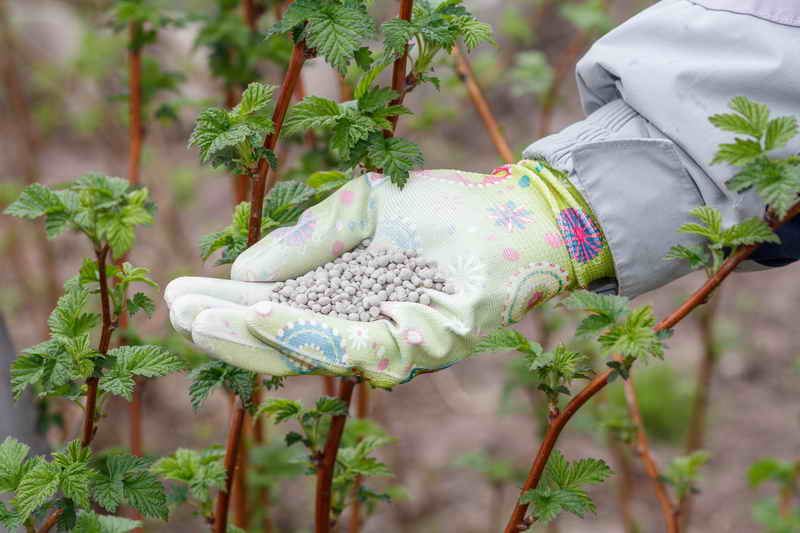

Thus, it is possible to achieve rapid growth and a large yield only with the timely application of organic and mineral fertilizers. However, you should be careful when using organics. Since this type of fertilizer gives off a large amount of ammonia, which can burn the roots. To prevent this from happening, top dressing is added in liquid form.In winter, it is recommended to put organic fertilizers in solid form at a short distance from the bush.
Planting raspberries Krepysh
You can get really generous harvests when the plant is planted on time and correctly, and the necessary nutrients are introduced for better rooting and development.
Timing
The most suitable time for planting Krepysh raspberries is March-April or the end of September-October.
Landing patterns
For spring planting, pits or trenches are prepared in the fall, and for autumn planting - at least 3 weeks in advance. You can plant Krepysh stock raspberries using a bush or trench method.
Bush planting
Consists of the following steps:
- Dig holes for each plant - 50x50 cm, the depth depends on the size of the root system of the seedling, usually 40-50 cm is enough.The distance between the seedlings is at least 0.5 m.
- Fill each pit with 1 bucket of compost, or put rotted manure on the bottom (peat with manure is possible). Be sure to add phosphate fertilizers - 1 / 3-1 / 2 matchbox. If there is no manure, you can add mineral nitrogen fertilizers, for example, ammonium nitrate - 1 tbsp. l. 10 liters of water.
- Mix the fertilizers in the planting holes well with the soil.
- A couple of hours before planting, immerse the plant roots in water with the addition of the stimulant Kornevin or Heteroauxin.
- Place the seedling in the planting hole, straighten the roots, sprinkle with fertile soil, compact and water well (5-6 liters of water under the bush).
- After watering, when the ground has slightly subsided, the seedling should be buried 1.5-3 cm below the level at which it grew in the nursery.
- Prune the plant at a height of 30 cm.
- Form a hole around the seedling, and mulch the surface with rotted sawdust, straw, compost, peat or other organic matter. The thickness of the mulch layer is 8-10 cm.
Trench way
The trenching method practically does not differ from the bush planting. The only difference is that instead of separate holes, one long furrow is dug and filled with fertilizers.


For 1 running meter of the trench, 5-6 kg of humus, 30-40 g of potassium sulfate or other potassium fertilizers that do not contain chlorine, and 60 g of superphosphate are applied. Potash fertilizers can be replaced with wood ash - 200-300 g.
When planting by trenching, the distance between plants is 0.6-1 m.If there are several rows, the distance between them is at least 2 m.
In autumn planting, the lower buds of the plant are hilled.
Landing
When planting raspberries Krepysh, you must adhere to certain rules. Then it will grow quickly and bear fruit well. The tree needs a sunny spot. It is recommended to choose loamy or sandy loam soil. It is worth noting that there is no consensus among gardeners when to plant raspberries. This can be done either in the fall or in the spring. In the first case, the probability that the root will freeze is minimal. In the second, the root system will become strong enough to survive very low temperatures.
Landing takes place as follows:
- Holes or a trench are dug, 60 cm deep. The distance between the holes is also 60 cm. It is recommended to make a distance of about 1.3 m between the rows, so it will be easier to harvest.
- Organic fertilizers are placed in the hole. It is advisable to use humus so that ammonia does not burn young roots.
- A raspberry bush is installed and buried. The earth is compacted slightly.
- The plant is watered.


Reference. Some gardeners first moisten the soil and then plant a raspberry bush. Then the roots are better fixed in the ground. Both methods are actively used today and do not affect the yield.
Raspberry care
Caring for the standard raspberry Krepysh is exactly the same as for any other type of this plant, and consists in loosening, weeding, watering and feeding:
- Watering. The variety gives an increased yield, therefore, raspberries require more moisture. Watered at least 1 time per week. Standard raspberry is hygrophilous, but does not tolerate stagnant water.In rainy and cloudy weather, it is not watered, so as not to cause rotting of the roots.
- Top dressing. During the season, at least 3 dressings are carried out, it is better to combine them with watering: First, in the spring they are fed with nitrogen fertilizers during the period of leaf bud opening. An infusion of mullein is used, which must necessarily ferment, or mineral nitrogen fertilizers, for example, urea (50 g per 10 l of water). This amount is enough for 3 raspberry bushes. You can use ammonium nitrate. Practicing nitrogen fertilization in the snow. For each square. m of raspberries are scattered with a mixture of ammonium nitrate (10 g) and urea (8 g). When the snow melts, fertilizers fall along with the melted water to the root system of plants.
- The second – in the budding phase, they give a complete complex fertilizer containing potassium, phosphorus, nitrogen. Suitable nitroammofosk, 10 g of which is diluted in 10 liters of water.
- The third is carried out in the fall, at the end of the growing season, phosphorus-potassium fertilizers are applied.
Gardeners reviews
Standard raspberry Krepysh, like ordinary varieties, is very fond of well-lit areas with fertile and well-drained soils. Therefore, experienced gardeners recommend placing plants from south to north. According to reviews, the Krepysh variety gives high yields of large berries. The stems of the plants are very powerful, without thorns.
The conditions for the successful cultivation of Krepysh raspberries are the same as for any standard raspberry: applying a sufficient amount of fertilizers, timely watering, regular removal of excess growth and competent protection of plantings from pests and diseases.
Preparation for wintering
The high frost resistance of Krepysh raspberries allows you to do without shelter for the winter in regions where there are no prolonged severe frosts. Temperature -20 ° С is not dangerous for the plant. But with strong winter winds, the Fortress needs to bend to the ground.
The winter hardiness of the culture increases if in the fall, at the end of October - beginning of November, water-charging irrigation is carried out - 50 liters of water per square meter. m raspberry.
In regions with a harsh climate, in preparation for wintering, raspberries are bent to the ground and covered with agrofibre. It is good if the bushes are under heavy snow cover.
Pruning
Spring and autumn pruning of raspberries is carried out. Immediately after the snow melts, remove all dead wood using a garden pruner. Shoots formed during the last season are shortened by 10-15 cm (the growth point is removed). The harvest of the current year will ripen on them. Pruning will stimulate the growth of young twigs.
Correct pruning is to leave 12-15 large stems per 1 m2.
In any raspberry plant there are two types of shoots - one-year and two-year. The first ones are left in the amount of 6-8 per 1 m2. They will bear fruit next season. In spring pruning, the strongest are left, with intact bark. Weak ones are cut with pruning shears as close to ground level as possible. In July, the tip of the left shoots is pinched.
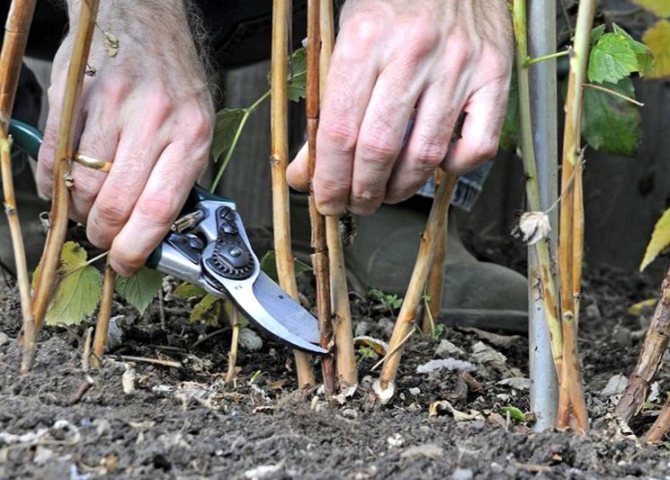

Autumn pruning is the complete removal of two-year-old shoots after harvest. This procedure can be performed in spring, but autumn is most favorable for the plant. It will not waste energy on maintaining branches, which will be deleted anyway.
Pruning and shaping the crown
It is usually recommended to pinch the top of annual shoots when they reach a height of 1.5 m. But the stems grow to this size by the end of summer.As a result, few lateral shoots are formed, and they do not have time to ripen by winter.
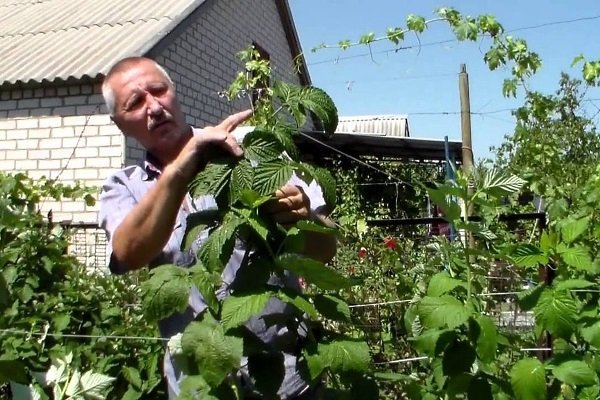

There is a smarter approach to the formation of standard raspberries, tested by gardeners in practice. The double cropping method is used. In late May and early June, pinch the top at a height of 50 cm.
Pinching stimulates active germination of lateral shoots. The bush during this period has a lot of strength and enough time for their formation and growth. When the length of the lateral shoots that have grown on the main stem reaches 50 cm, they are also pinched.
With this variant of plant formation, the shoots have time to get stronger before winter. The next year, many fruitful twigs will form on them.
After completing the harvest, the fruit bearing shoots are cut off. Better not to tighten until spring, and cut them out in August. In this case, the replacement shoots will have time to mature well.
Formation in subsequent years consists in the removal of dry branches in the spring. In the summer (in June), pinch the top, in July, the lateral shoots are shortened.
Read articles on how to properly prune raspberries in the fall and spring.
Planting seedlings on the site
Before planting a new variety on the site, you need to mark the beds for the future raspberry tree. The marking of the beds is carried out using pegs and a cord stretched between them.
Along the borders of the bed, after the cords are stretched along its borders, fertilizers are laid out on the surface of the soil. Next, the raspberry tree must be dug up. And the last stage of the formation of a raspberry bed: the gardener, walking along the future berry field, rakes the soil from the middle of the garden to its sides.
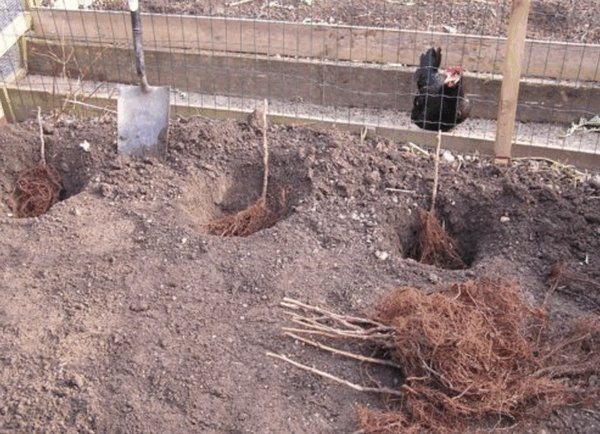

The garden bed turns out to be slightly curved towards the middle (like a trough or a boat). This shape will help the grower in further caring for the plantings: watering the beds or applying liquid fertilizers, you do not have to worry that the liquid will flow out of the raspberry tree. All moisture will go to the roots of the plants for which it was intended.
Planting holes are dug according to the finished marking of the rows for planting. It is not necessary to lay fertilizer in them, since the soil under the raspberry tree is sufficiently fertilized in advance. A bucket of water is poured onto each pit and, after absorbing, a seedling is placed vertically with neatly straightened roots. The plants are covered with earth and watered again. This contributes to the fact that the soil is compacted and envelopes the roots of the seedlings.
Timing
Raspberries can be planted in autumn and spring, but with autumn planting, young plants have more time for adaptation and rooting than in the hot summer period.
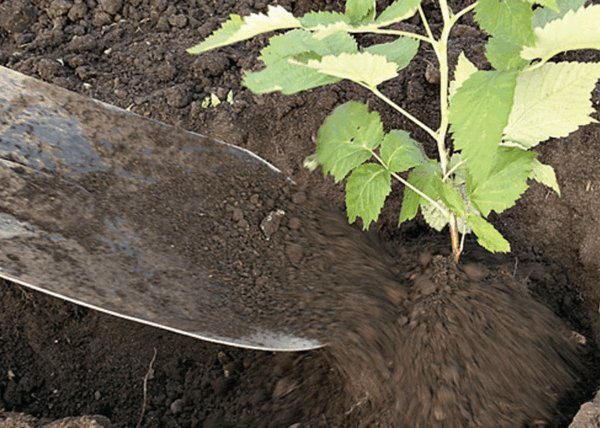

If the gardener decided to carry out a spring planting, then this should be done in early April, before the leaves bloom on the raspberries. In autumn, seedlings are planted from late September to late October.
Scheme
Raspberry tree "Krepysh" is a standard and not too high variety, so the distance between two berry beds when planting can not be more than 1.5 meters. This is a convenient distance for further care of raspberries.
Important! The width of the future berry bed is no more than one and a half meters. A garden bed of exactly this width allows the gardener to conveniently pick berries even in the middle of a raspberry tree.
"Krepysh" can be dropped off:
- in single-row fit - with a berry bed width of 1.5 m, the plants are planted along the bed in one row (adhering to the center). The distance between the seedlings should be at least 50 cm. In the process of growth in subsequent years, the roots of raspberries will fill the entire garden.
- in two-row planting - with the same bed width as in a single-row planting, the plants are planted in two rows.
Important! In order to correctly mark the location of the two planting rows relative to the center of the bed, measure 35 cm to the left from the middle of the bed, this will be the left row of raspberries. In the same way, 35 cm recede from the center of the garden bed to the right - here the second row of plantings will begin.The distance between the raspberry seedlings is 50 cm, the distance between the two rows is 70 cm. When planting, the seedlings in adjacent rows are staggered.




How to propagate a variety?
Raspberry Krepysh can be propagated by shoots, green, as well as root cuttings.
Undergrowth
The easiest way is to propagate by root shoots-offshoots, which appear in the spring near raspberry bushes.
The strongest and strongest are chosen, left for the summer, and by autumn, when they develop normally, they are dug up and transplanted with a clod of earth to a prepared place.
Green cuttings
This is the second most popular method used both in spring and autumn. The main thing is that at least a month remains from the planting of rooted cuttings before the onset of cold weather.
The optimal time for harvesting cuttings is late May-early June. Young shoots are the source of cuttings in spring, and healthy annual shoots in autumn.
Breeding raspberries with green cuttings:
- Cut the young shoot into 8-15 cm pieces (each has at least 2-3 buds). To stimulate root formation, make several longitudinal shallow cuts, 2-3 cm long, in the lower part of the cutting with a sharp knife.
- Cut off the top and leave 1-2 leaves on each cutting.
- Then the cuttings, tied in bunches, are placed in a rooting stimulator (Heteroauxin, Kornevin) for about a day. Only the tips (slices) of the cuttings should be in the solution.
- Plant the cuttings into the soil, deepening 1/3 of the length, at an angle of 45 degrees, between plants - 5-7 cm, between rows - 7-10 cm. A greenhouse or a small film shelter is suitable for this purpose.
- Water. In the future, make sure that the soil is constantly moist.
- After 4-5 weeks, transfer the rooted cuttings to a permanent location.
Root cuttings
The method is optimal for reproduction of raspberry varieties that form little overgrowth. These include Krepysh. This breeding option is suitable for plants in which the aerial part is affected by the disease.
This is done in autumn or early spring, until the roots have released green shoots:
- Dig up the bush and shake the soil off the rhizome. You can take cuttings from both annuals and perennials.
- Choose roots with a diameter of 2-3 mm that have renewal buds. The length of the cut root cuttings is 10-15 cm. Do not take the upper lobe roots; replacement buds are not laid on them.
- If cutting is carried out in the fall, and there is a fear that cuttings planted in the ground will freeze in winter, store them in the basement in wet sand or peat until spring.
- Plant in grooves to a depth of no more than 5 cm. When planting in autumn for the winter, be sure to mulch the soil well with peat, rotted manure or other breathable material.
- Transplant to a permanent location in warm weather (April-May).
Watering
One of the most important aspects of caring for robust raspberries is watering. It is carried out at intervals of 1 time in 5-6 days.


at the rate of 4-5 liters per bush. As the raspberries grow, the amount of water increases.
In hot summer, to retain moisture, the soil around the bush is covered with a 5-7 cm layer of mulch. You can use sunflower husks, crushed corn stalks, sawdust, wood shavings, straw. It is not recommended to cover with cereals, as this is fraught with germination of grains this or next year.
In agricultural technology there is such a technique as winter watering of raspberries. It is carried out from the third decade of October to mid-November. It is believed that in this way they increase the yield of the bushes in the next season. Reception consists in abundant watering of the raspberry plant at the rate of 50 liters per 1 m2.
Diseases, pests and control of them
Under unfavorable conditions, insufficient lighting and thickening of plantings, pathogens and pests accumulate on the plants. But even with proper care with all agrotechnical measures, the raspberry plant is not immune from diseases, many of which are carried by insect pests.
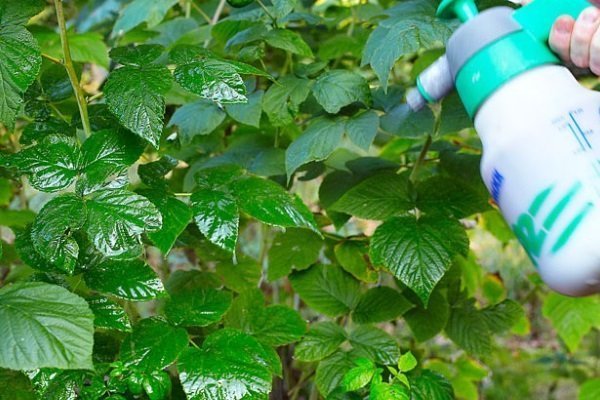

Tables 1 and 2 show pests and diseases that pose a threat to Krepysh raspberries, as well as control and prevention measures.
Table 1
| Pests | Harm done | Control measures |
| Raspberry-strawberry weevil (flower beetle) | It bites the pedicels, the buds fall off or break off and wither. | Treatment before and after flowering with Fufanon, Kemifos or Alatar (according to the instructions). |
| Raspberry beetle | Beetle larvae damage fruits (wormy berries). | 1. Loosening the soil in early spring and during the growing season, weeding. 2. Spraying at the beginning of June with 1% karbofos during the blooming period of the first flowers. |
| Stem raspberry gall midge | Galls are formed on the stems, inside of which are orange larvae. Shoots crack, weaken. Above the swelling, the stem dries up and breaks off. | Affected shoots are cut 3-4 cm below the bulge and burned. Spraying before flowering with insecticides: BI-58, Aktellik, Alatar, Inta-Vir, etc. |
table 2
| Disease | Symptoms | Treatment |
| Anthracnose | Grayish-white spots with a purple border. The entire aboveground part of the bush is affected. The bark flakes off, the leaves dry out. | Infected bushes are removed, the raspberry is treated three times per season with copper-containing preparations: Oxykh, HOM, a solution of copper sulfate. |
| Gray rot | It affects leaves, shoots and fruits. The berries are covered with a fluffy coating and rot. | Diseased plants are immediately disposed of, healthy plants are treated with fungicides. |
A proven way to protect bushes from fungal diseases is spraying with Bordeaux liquid. In early spring, before the leaves bloom, a 3% solution is used, and in the budding phase - a 1% solution. Treatments are also aimed at preventing bacterial diseases.
Diseases and pests
The Krepysh variety is distinguished by its high resistance to diseases, but there is always a risk of plant infection.


The most common diseases:
- powdery mildew;
- anthracnose;
- chlorosis;
- yellowing of the leaves.
Treatment is carried out in accordance with the recommendations for combating these diseases. For "Krepysh", pests are the most dangerous. One of them is aphid. Signs of damage cannot be overlooked: parasites colonize the ends of shoots and inflorescences. For the destruction of insects, they are treated with Karbofos or Aktellik.
Another common pest is the raspberry beetle. This insect can be recognized by its yellow stripes and gray hairs on its body.
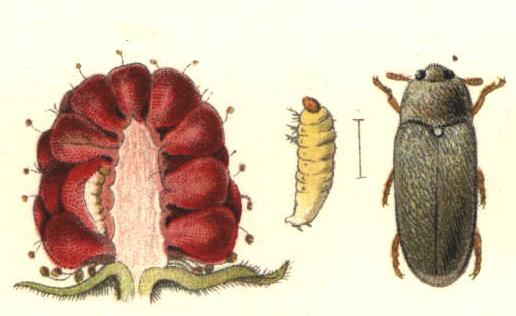

To get rid of the parasite, they are treated with the preparations "Confidorm", "Decis", "Karbofos".
Read more in our other article: Treatment of raspberries from diseases and pests. In spring and autumn
Reviews from gardeners about Krepysh raspberries
★★★★★
Elena, 39 years old, summer resident, Volgograd region. Our Krepysh has new shoots every spring, but the raspberry tree does not overgrow. I cut the bushes only when necessary, once every 2-3 years. The berries ripen quickly, picked them in the evening, and by the next evening there are many red ones again. I'm happy with the variety.
★★★★★
Olga Nikolaevna, 50 years old, gardener, Rostov. I liked the Krepysh variety because there is no need to tie the raspberries to the trellis. Gardeners are aware of how much labor and time it takes to tie plants to supports. There is no such hassle with this variety. The harvest is generous, the berries are dense, do not fall apart.
Hide
Add your review
The standard raspberry variety Krepysh is endowed with large berries, resistance to diseases and frosty winters, and is capable of producing a rich harvest with easy care. Such advantages distinguish it from other varieties. This is worth using when growing raspberries on your site.
0
Raspberry tree - what is it?
Raspberry trees are popularly nicknamed the standard varieties of culture, which are distinguished by thickened stems. Bushes of such raspberries do not resemble trees at all, but their trunks are stronger, do not droop. With a certain type of pruning, you can achieve that the standard raspberry will look like a small tree.
Among the benefits of the raspberry tree are:
• unpretentious care; • the raspberry grove does not thicken, since very little root growth is formed; • increased productivity due to a large number of side shoots; • berries are large, well stored, contain few seeds; • tall bushes facilitate harvesting; • strong trunks do not break under the force of winds and the weight of ripe berries; • cold resistance - berries from some varieties can be harvested until late autumn.
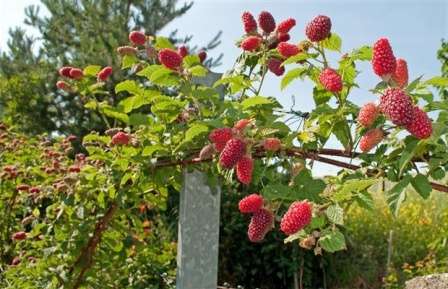

However, in addition to the advantages, gardeners also note one significant drawback of the raspberry tree. According to their observations, the berries from such bushes do not have such a pleasant taste and aroma as the berries of ordinary raspberries.Do not forget that a lot depends on the composition of the soil, the amount of moisture and the sun.
At the end of the brief description of the standard raspberry varieties, let us name the most beloved by gardeners: "Orange Miracle", "Sun", "Golden Domes", "Arbat", "Krepysh", "Fairy Tale". The position of the leader in this list has been occupied by the standard raspberry variety "Tarusa" for several years. Some of the listed varieties of standard raspberries are shown in the photo.
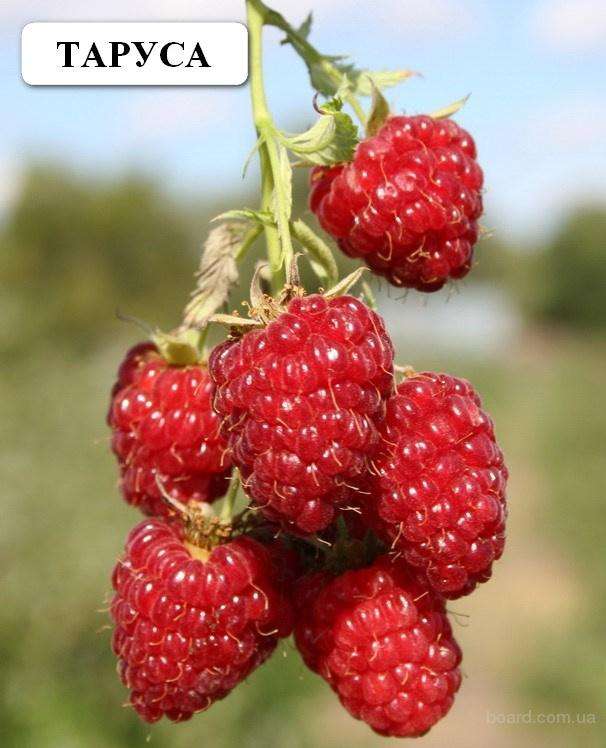

On the photo there is a raspberry of the "Tarusa" variety. On the photo there is a raspberry tree "Orange Miracle"


In the photo, raspberry "Krepysh"
a brief description of
The Krepysh variety was obtained by domestic scientists in 2000. Raspberry fully lives up to its name. Her shoots are thick and powerful. They do not bend either under the weight of a strong gusty wind or under the weight of the crop. Despite its impressive size (the average height of the culture is 1.8 m), the tree does not need supports and other support. The maximum that he needs with the bush planting method is a fence.
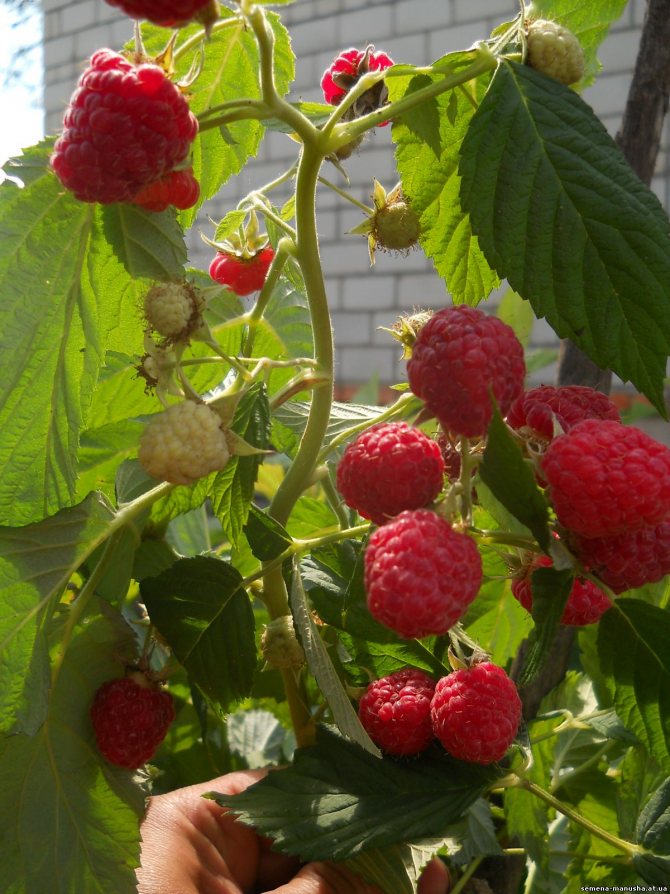

"Krepysh" is a mid-early variety. The berries ripen on last year's branches. The yield indicators are good. From one plant (subject to agricultural technology), you can get 4 kg of fruits. Raspberries are large, rich red, neat in shape, sweet and sour taste.
One of the advantages is a dense structure that allows you to maintain high commercial characteristics during storage and long-term transportation.
Ripe berries are easily separated from the stalks. Raspberries are good for fresh consumption and for making compotes, preserves and jams.
The variety is resistant to low temperatures, which allows it to be grown in almost any region. Easily tolerates lowering the thermometer to -30 degrees. "Strong" possesses about - is rarely affected by diseases and pests.
Choosing seedlings
Buying quality planting material is a guarantee that the result will meet expectations. Relate to
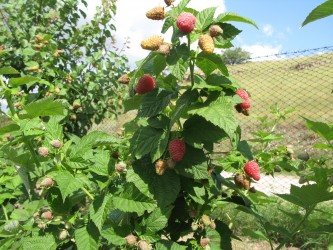

this is responsible.
Signs of a good seedling are:
- the presence of at least 3 buds at the base of the stem;
- woody sturdy stem;
- the diameter of the shoot is not less than 1 cm.
The absence of 3 buds is evidence that the seedling is very young. It is not worth purchasing this - it will take more time for the formation of branches and growth. Plants with a woody stem have developed roots, which will allow them to quickly adapt to new conditions. The length does not play a special role - all the same, the stem will be shortened during planting, but the diameter is important. Thin trees do not take root well.
Raspberry Krepysh: advantages and features of growing a raspberry tree
Recently, more and more often you can hear about the raspberry tree. What kind of miracle is this and how does it differ from everyone's favorite bush raspberry? In fact, there are no miracles. The raspberry tree, or standard raspberry, is a plant with a thick trunk reaching a height of 2 meters. Planting standard raspberries is a modern direction of breeding science, which has recently become widespread. There are several varieties of such raspberries and one of the most popular is "Krepysh". It seems that this variety consists of some advantages. But is it really so? Let's figure it out together!
Features of the variety
Each spring, the raspberry tree sprouts a small number of new shoots. However, in the first year they will not bloom - the berries will appear only the next year. Ripe fruits do not fall off the branches, which greatly facilitates harvesting - the need for relentless control over ripe raspberries disappears.
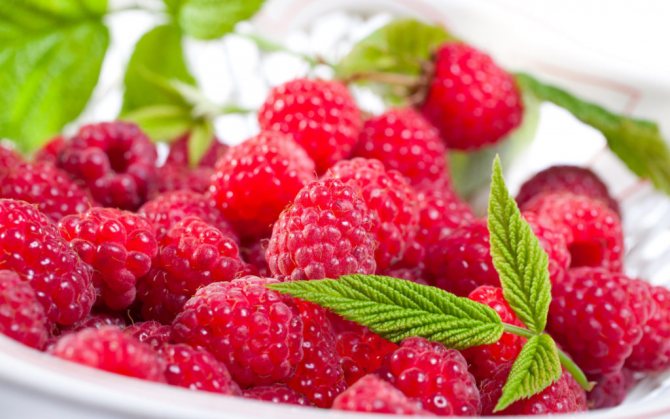

Don't expect quick results after planting. Fruiting will begin in 2-3 years, and you can only harvest a full harvest for 5 years. But it's worth it. Raspberries are beautiful, fragrant and delicious. It ripens unevenly, that is, you get the opportunity to feast on a juicy berry for a long time.
Read also: Raspberry variety Gusar - description, planting, care, reviews
"Strong" does not tolerate damage to branches.If you inadvertently break the stem, then cut it off a couple of centimeters below the break. Otherwise, the plant may die. Try not to transplant raspberries unnecessarily. For her, this is the strongest stress. It will take 2 years to restore fruiting.
The tree is designed not only to bear tasty fruits - it can decorate any plot of land. The fact is that the buds are very densely located on the trunk - every 1-2 cm. This transforms the culture during the appearance of flowers and berries - the tree looks very elegant.
Care advice
Raspberry care, regardless of type and variety, is usually standard. Raspberry Krepysh is able to form high yields only if agricultural technology is followed:
- Standard raspberries are demanding on irrigation, especially at the fruiting stage, therefore watering is carried out throughout the entire period of active growing season, at weekly intervals, at the rate of 5 liters of water for each productive bush.
- To obtain a high and high-quality yield, root shoots and weeds in the aisles are carefully removed throughout the growing season.
- In the spring, to protect against fungal and bacterial infections, plants are treated with a 1-3% solution of Bordeaux liquid or Topaz diluted with water at a rate of 1: 1.
- In early spring, plantings are fed with a urea solution or infusion of bird droppings / mullein with the addition of a small amount of wood ash.
- After root dressing, be sure to carry out abundant watering, as well as shallow loosening and mulching of the soil.
- At the end of the harvest, fertile, weak and broken shoots are removed, leaving five to six of the strongest and most developed. For the winter, raspberries are sheltered only in regions with very harsh, frosty winters.


